Online copyright infringement tracker survey (10th Wave) executive summary
Published 30 March 2021
Executive summary
This wave of the research was asking about a period markedly different from previous years. For much of the time-period respondents were being asked to reflect on (i.e. the previous three months) and during the time of fieldwork, the UK (and much of the world) was in a state of lockdown owing to the COVID-19 pandemic. Many data points, perhaps as a result, appear to have shifted when compared to last year’s study.
Overall summary
-
consumption (i.e. downloading or streaming content online) was consistent across a number of categories compared to last year. There were some key differences which included a decline in the proportion of our sample who had downloaded music and TV. There was also a decline in the proportion who had streamed live sport and an increase in those streaming films
-
passion for the content categories remained robust during the COVID-19 pandemic with respondents agreeing that many of them played a central role in their lives
-
the main drivers for online consumption were cost, the choice available and the convenience of being able to consume content whenever they want
-
the overall level of infringement for all content categories (excluding digital visual images) was at 23%, which is 2% lower than where it had been for the previous four years
Notable changes in consumption compared to 2019
TV streamers over the past three months (average number of legal hours):
| 2019 | 2020 |
|---|---|
| 93 hours | 122 hours |
Film streamers over the past three months (average number of legal hours):
| 2019 | 2020 |
|---|---|
| 57 hours | 77 hours |
- the proportion who had streamed films over the previous three months was up by 8% to 42% - the highest it has been over the past six years and matches the proportion of those who had streamed TV. The amount of legal content consumed in both categories also increased while the amount of illegal content either remained the same or decreased
Music tracks downloaded legally over the past three months (average):
Legally
| 2019 | 2020 |
|---|---|
| 75 | 80 |
Illegally
| 2019 | 2020 |
|---|---|
| 10 | 21 |
- the proportion who had downloaded music was down (by 8% to 23%) compared to last year, with the proportion streaming remaining broadly unchanged (3% decrease to 37%). Despite a decrease in the overall proportion downloading, the volume of tracks downloaded by both legal and illegal methods per respondent increased
% who had streamed live sport:
| 2019 | 2020 |
|---|---|
| 14% | 8% |
- the proportion who had streamed live sport had almost halved compared with last year
Infringement levels
Overall infringement level
23%
Below average infringement levels
TV, audiobooks and video games were notably lower than average infringement levels.
TV: 14%
Audiobooks: 14%
Video games:11%
Average infringement levels
Film, software, music and e-books were around, or just below, average infringement levels
Film: 20%
Software: 20%
Music:18%
E-books: 17%
Above average infringement levels
Above average infringement levels were seen for live sports and digital magazines.
Live sports: 37%
Digital magazines: 28%
Qualitative summary
In the qualitative phase of research, respondents elaborated on the peculiarities and extraordinary circumstances of this year, detailing some of the surprising benefits as well as the challenges and struggles which came with the experience of lockdown. Those who had been furloughed reported a definite increase in their consumption of their favourite forms of entertainment while those who were still working and studying mostly noted their consumption had remained relatively consistent.
The reason for an increase in entertainment consumption among those with lots of free time during lockdown was the comfort and distraction found in activities such as reading, listening to music, watching films and playing video games etc. Respondents relied upon these activities to fill their time from a practical perspective but also to take their mind off the real world and to help combat stress, boredom and anxiety.
In terms of levels of infringement, the findings from the qualitative phase showed that while many reported no change in their use of illegal sources, some noted that owing to their general consumption in entertainment increasing, so too did their use of illegal sources. Motivations for doing so remained consistent with those uncovered in the previous wave (2019); a lack of access to specific content on streaming subscriptions they use, availability on existing entertainment subscriptions and/or an unwillingness to pay additional costs for content outside of what they already pay for.
The closing exercise of the Online Community focused on potential communication materials and messages to try and encourage behaviour change around online infringement. Using the segmentation of respondents established in last year’s study, this exercise showed that a number of types of messages were effective for ‘Cautious Infringers’ - those who are uneasy and unsure about illegally accessing content, highlighting the need for education and awareness. Yet, it emerged that in order to try and reach those who are harder to engage in behaviour change, i.e. the ‘Savvy Infringers’, the most effective way to talk about the consequences of infringement was by focusing on the impact on the individual - both within the industry as well as the impact on the individual consumer through risks to their own hardware and devices.
Music
Engagement with music
Streaming was the most common method of accessing music, with 37% having done so in the past three months. Downloading followed at 23%, with notably fewer having purchased physical music (11%).
While streaming music remained relatively stable compared to last year (a decline of 3%) downloading and physical purchases experienced steeper declines of 8% and 9% respectively.

Music Streamed 37% (-3%) Downloaded 23% (-8%) Physical Purchases 11% (-9%) (+/- compared to OCI 2019)
Infringement
The overall level of infringement (i.e. anyone who had used an illegal source for music in the past three months) remained consistent, from 20% in 2019 to 18% in 2020. The only notable shift in the type of infringement was in the decline of those using only legal sources to download music.
| Downloaders and streamers |
Downloading | Streaming | |
|---|---|---|---|
| Only legal | 82% (+2%) | 66% (-4%) | 99% (+1%) |
| Mix | 16% (-2%) | 18% (+2%) | 1% (-1%) |
| Only illegal | 2% (0%) | 16% (+2%) | 0% (0%) |
Film
Engagement with film
Streaming was the most common method of accessing films, with 42% having done so in the past three months. Downloading followed, some way behind, at 18%, with slightly fewer having purchased physical copies (decrease of 9%).
Streaming saw a noteworthy increase compared to last year (8% growth). Downloading remained stable (a 1% increase) while physical purchasing saw a decline of 9%

Films Streamed 42% (+8%) Downloaded 18% (+1%) Physical Purchases 13% (-9%) (+/- compared to OCI 2019)
Infringement
The overall level of infringement (i.e. anyone who had used an illegal source for films in the past three months) experienced a large decline going from 27% in 2019 to 20% in 2020. The main notable shift in the type of infringement was the increase in those using only legal sources.
| Downloaders and streamers | Downloading | Streaming | |
|---|---|---|---|
| Only legal | 80% (+7%) | 77% (+2%) | 84% (+6%) |
| Mix | 17% (-5%) | 14% (+0%) | 13% (-5%) |
| Only illegal | 3% (-1%) | 9% (-2%) | 2% (-1%) |
TV
Engagement with TV
Streaming was the most common method of accessing TV, with 42% having done so in the past three months. Downloading followed, some way behind, at 16%, with relatively few having purchased physical copies (4%).
Downloading saw a noteworthy decrease compared to last year, falling by 7%. Streaming remained stable with no change while physical purchasing saw a modest decline of 2%.

TV Streamed/accessed 42% (-0%) Downloaded 16% (-7%) Physical Purchases 4% (-2%) (+/- compared to OCI 2019)
Infringement
The overall level of infringement (i.e. anyone who had used an illegal source for music in the past three months) experienced a small decline going from 17% in 2019 to 14% in 2020. There was no notable shift compared to last year in terms of the type of infringement with a slight increase in those using only legal sources.
| Downloaders and streamers | Downloading | Streaming | |
|---|---|---|---|
| Only legal | 86% (+3%) | 82% (+2%) | 89% (+3%) |
| Mix | 12% (-2%) | 11% (+1%) | 9% (-2%) |
| Only illegal | 2% (0%) | 6% (+1%) | 1% (-1%) |
Live sport
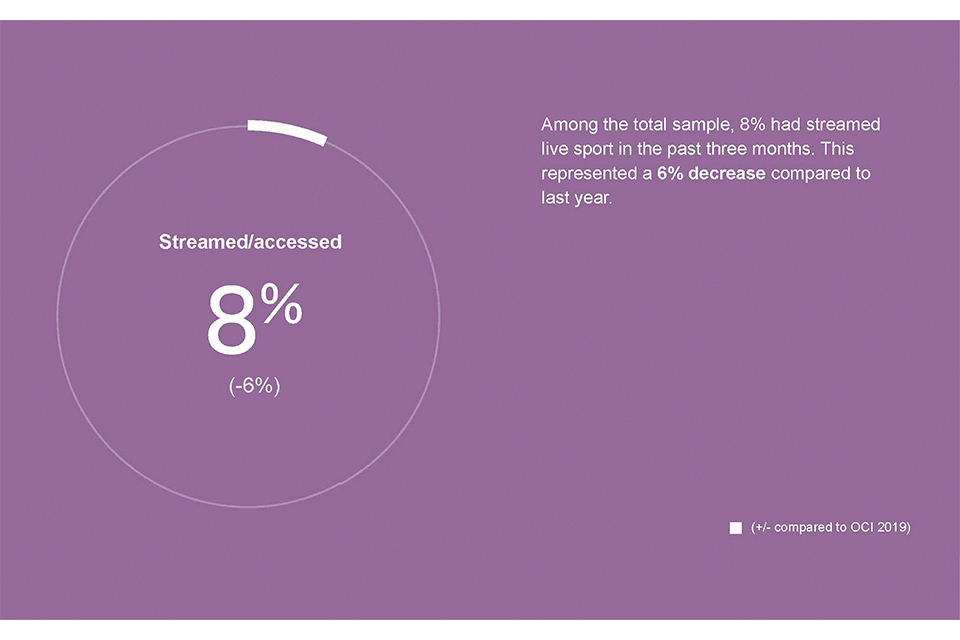
Live sport Streamed/accessed 8% (-6%) (+/- compared to OCI 2019)
Infringement
The overall level of infringement (i.e. anyone who had used an illegal source for live sport in the past three months) experienced a small increase going from 34% in 2019 to 37% in 2020. Compared to last year there was a decline in those using only legal sources.
| Streamers | |
|---|---|
| Only legal | 63% (+4%) |
| Mix | 25% (+2%) |
| Only illegal | 13% (+2%) |
Video games
Engagement with video games
Downloading was the most common method of accessing video games, with 16% having done so in the past three months. Streaming followed at 11%, with marginally fewer having purchased physical copies (9%).
Downloading remained relatively stable compared to last year (a 2% decline) while streaming/accessing remained at exactly the same level. Physical purchases experienced a decline of 4%.
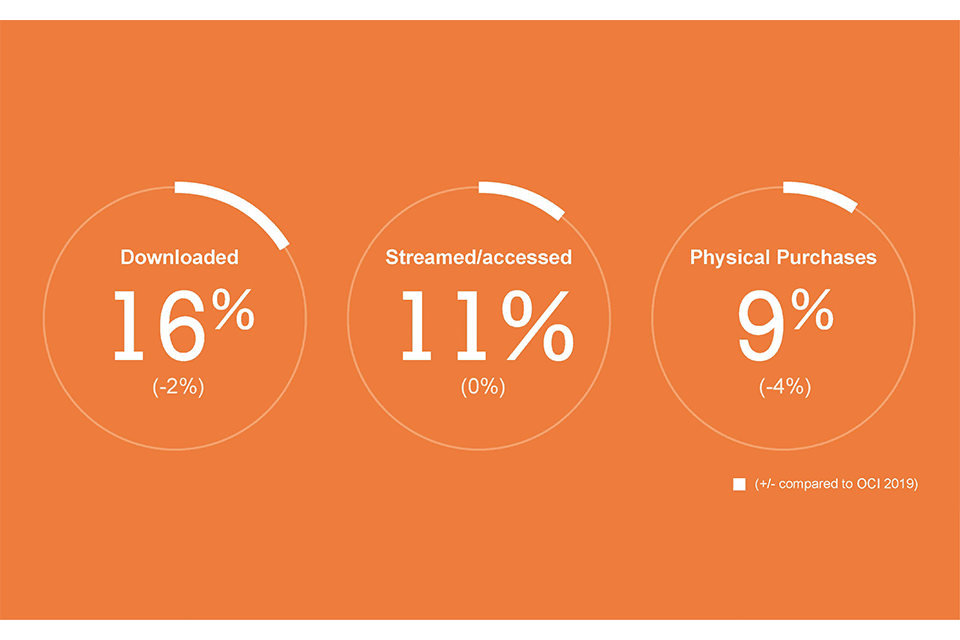
Video Games Downloaded 16% (-2%) Streamed/accessed 11% (-0%) Physical Purchases 9% (-4%) (+/- compared to OCI 2019)
Infringement
The overall level of infringement (i.e. anyone who had used an illegal source for video games in the past three months) experienced an increase, from 6% in 2019 to 11% in 2020. Compared to last year there was a decline in those using only legal sources.
| Downloaders or streamers/accessors | |
|---|---|
| Only legal | 89% (-5%) |
| Mix | 8% (+3%) |
| Only illegal | 2% (+1%) |
Software
Engagement with software
Downloading was the most common method of accessing software, with 18% having done so in the past three months. Streaming followed, some way behind, at 8%, with fewer having purchased physical copies (4%).
Downloading remained relatively stable compared to last year (a 2% decline) as did streaming and physical purchasing (both experienced a 1% decline).
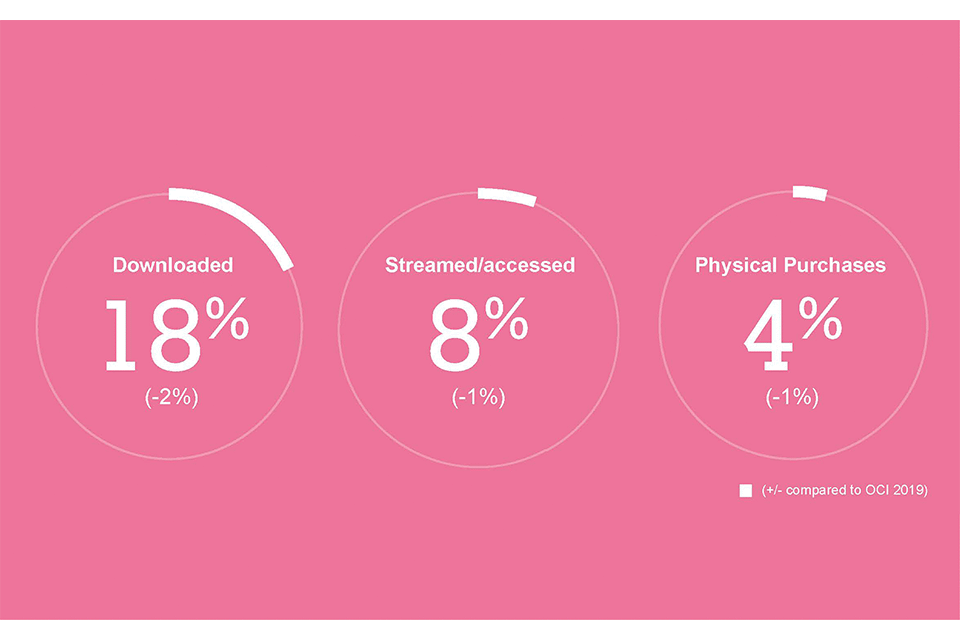
Software Downloaded 18% (-2%) Streamed/accessed 8% (-1%) Physical Purchases 4% (-1%) (+/- compared to OCI 2019)
Infringement
The overall level of infringement (i.e. anyone who had used an illegal source for software in the past three months) experienced a small increase going from 18% in 2019 to 20% in 2020. There were no notable shifts compared to last year in terms of the type of infringement.
| Downloaders or streamers/accessors | |
|---|---|
| Only legal | 80% (-2%) |
| Mix | 8% (+1%) |
| Only illegal | 12% (+1%) |
E-books
Engagement with E-Books
Physical purchasing was the most common method of accessing books (i.e. physical books or e-books), with 26% having done so. This was followed closely by downloading (20%), with streaming/ accessing (8%) some way behind.
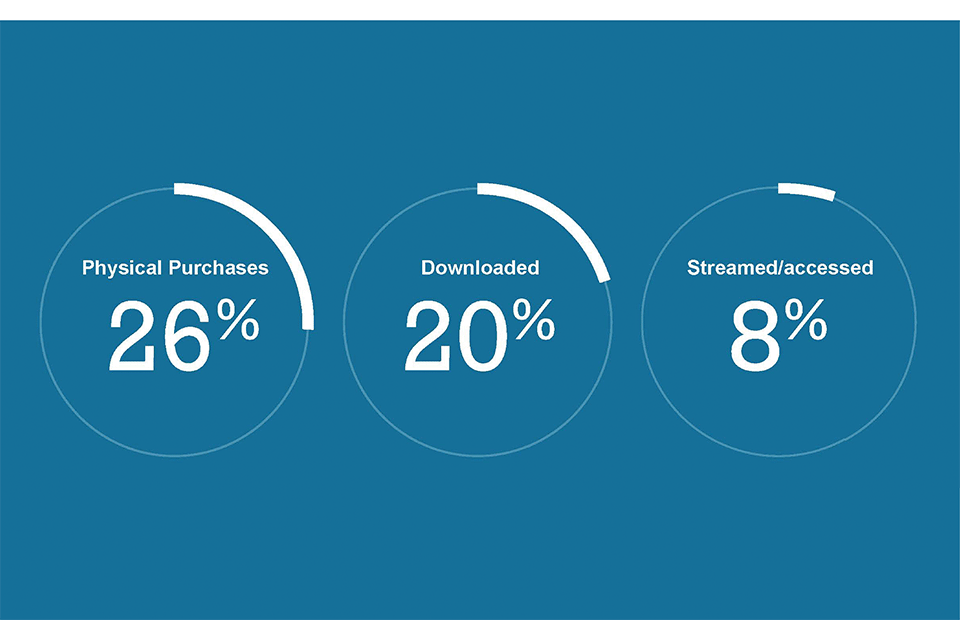
E-books Physical Purchases 26% Downloaded 20% (-2%) Streamed/accessed 8% (+/- compared to OCI 2019)
Infringement
The overall level of infringement (i.e. anyone who had used an illegal source for e-books in the past three months) was 17% this year. The proportion who had used only illegal sources (7%) was only marginally lower than those who use a mix of legal and illegal (10%).
| Downloaders or streamers/accessors | |
|---|---|
| Only legal | 83% |
| Mix | 10% |
| Only illegal | 7% |
Digital magazines
Engagement with magazines/digital magazines
Physical purchasing was the most common method of accessing magazines/digital magazines, with 12% having done so. This was followed, by some way, by downloading (6%) and streaming/accessing (5%).

E-books Physical Purchases 12% Downloaded 6% (-2%) Streamed/accessed 5% (+/- compared to OCI 2019)
Infringement
The overall level of infringement (i.e. anyone who had used an illegal source for digital magazines in the past three months) was 28% this year. The proportion who had used only illegal sources (17%) was higher than those who had used a mix of legal and illegal (11%).
| Downloaders or streamers/accessors | |
|---|---|
| Only legal | 72% |
| Mix | 11% |
| Only illegal | 17% |
Audiobooks
Engagement with audiobooks
Downloading was the most common method of accessing audiobooks, with 8% having done so in the past three months. Streaming followed at 5%, with fewer having purchased physical copies (2%).
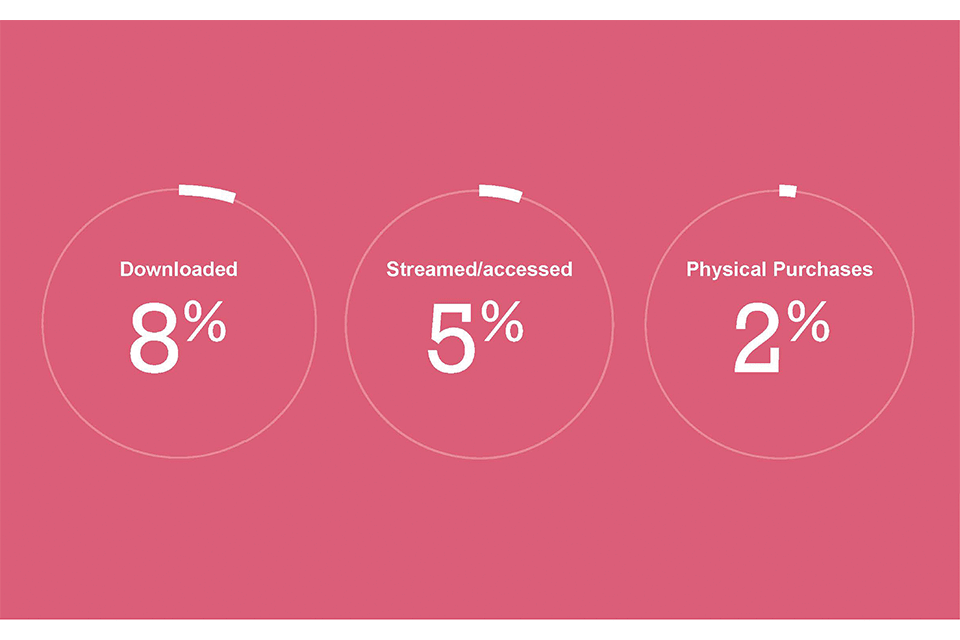
Audiobooks Downloaded 8% (-2%) Streamed/accessed 5% (-0%) Physical Purchases 2% (-4%) (+/- compared to OCI 2019)
Infringement
The overall level of infringement (i.e. anyone who had used an illegal source for audiobooks in the past three months) was 14% this year. The proportion who had used a mix of legal and illegal sources (8%) was similar to that of those who had used only illegal ones (6%).
| Downloaders or streamers/accessors | |
|---|---|
| Only legal | 83% |
| Mix | 10% |
| Only illegal | 7% |
Behaviour change opportunities
Key drivers of infringement
The qualitative phase of research, in the form of an Online Community, gave further insight into the particular motivations and attitudes attached to accessing content online, via both legal and illegal means. It sought, in particular, to assess the impact the recent months of unusual circumstances due to the coronavirus (COVID-19) pandemic may have had on such attitudes and behaviours.
As established in the previous (2019) wave of research, this year’s study reinforced that the key factors driving infringement across all entertainment categories are;
- cost and wanting to limit spending - particularly within categories where content is split across many different providers with separate subscriptions to pay for each
- the availability and broad range of content accessible via illegal sources which often offer people more options than legal methods
- the ease of access of illegal methods meaning that there are relatively few barriers to use
Despite the extraordinary backdrop to this year’s research, carried out during a government imposed lockdown due to the COVID-19 pandemic, these key drivers of infringement remained the same.
Encouragingly, despite some respondents in the Online Community voicing concerns about finances and budgeting during the lockdown period, none mentioned cancelling any of their online entertainment subscriptions or being more concerned about the cost of entertainment now than before the lockdown. Therefore, cost remained a key factor in accessing illegal sources of entertainment but did not appear to play a significantly more important role than before the impact of COVID-19 for most.
Communications testing
Respondents were shown a range of messaging focussed on showing the consequences of online piracy and infringement.
The types of messages shown fell into the following categories:
- messages describing the impact of infringement on the general economy
- messages describing the impact of infringement on entertainment industries
- messages describing the financial burden placed on these industries during lockdown
Key findings
What became overwhelmingly apparent through feedback from respondents was that, no matter which category the messages fell into, focussing on the story of an individual was the most effective way of encouraging acts of self reflection and potential behaviour change
Messages about the consequences to industries, big corporations or the economy failed to garner much empathy across the board whilst messages relating to COVID-19 were seen as potentially insensitive and only temporary in effect, given that lockdown would eventually end thus making them difficult to relate to.
Effective messaging for difference consumer types
Effective messaging for difference consumer types
As established last year, users of illegal sources mostly fell into two segments:
- cautious Infringers: Those who worry about infringing the law and the risks of illegal activity
- savvy Infringers: Those who are more tech savvy and knowingly access content illegally without much concern over related dangers or consequences.
The Communications Testing phase again revealed the contrasting needs and attitudes of both segments:
Considerations for cautious infringers:
- more likely to have a positive reaction to a broad range of messages.
- consider these messages informative and ‘eye opening’, leading to a potential change in attitudes and resulting behaviours
- particularly affected by stories of loss to individuals; artists, creatives or employees
Considerations for savvy infringers:
- sceptical about the true impact of illegal access on industries or of the opinion that industries must change, not consumers
- of the messages tested, those about potential harm to an individual in the industry had the most impact on this group
- messages about risk to the consumer through digital viruses etc. should also be considered for this group
There is potential to explore messages around risk of greater legal action and consequences for those who infringe - this is not currently seen as a viable threat but was mentioned by a few as a potential deterrent if enforced more widely.
